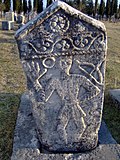| Medieval royal court of the Bosnian kings in Sutjeska | |
|---|---|
Bosnian: Stolno misto | |
 Reconstruction in sketch of the medieval royal court of the Bosnian kings in Sutjeska, based on layout of remains - looking west to east | |
 Royal court Sutjeska Location in Bosnia and Herzegovina | |
 | |
| General information | |
| Status | Destroyed |
| Type | Royal residence / court
|
| Architectural style | Romanesque, Gothic |
| Location | Kraljeva Sutjeska, Bosnia and Herzegovina |
| Coordinates | 44°07′19″N18°12′04″E / 44.121932°N 18.201187°E |
| Construction started | early 14th c. |
| Demolished | 1463 |
| Client | Bosnian bans and kings |
| Owner | state, (proscribed by KONS) |
| Technical details | |
| Structural system | Various low buildings surrounding courtyards, pavilions, gardens and royal chapel |
| Size | 2,500 to 5,000 m2 (27,000 to 54,000 sq ft) |
| Design and construction | |
| Engineer | unknown (probably local-traditional) |
| Designations | |
| Official name | Rulers’ court of the fourteenth and fifteenth centuries in Kraljeva Sutjeska, the archaeological site |
| Type | Category II cultural monument |
| Criteria | A, B, C i.iv.vi., D i.iv, F iii., G, H i., I iii. |
| Designated | 8 October 2003 (?th session) 06-6-42/03-3 |
| Reference no. | 1840 |
| State | National Monuments of Bosnia and Herzegovina |
Royal Court in Sutjeska was a medieval Bosnian court, residence, and administrative seat of the Bosnian king, from mid-fourteenth to mid-fifteenth century, located in present-day Kraljeva Sutjeska, Bosnia and Herzegovina. [1] The compound consisted of several buildings, chapel, and the nucleus of what would later become Kraljeva Sutjeska Franciscan Monastery.


